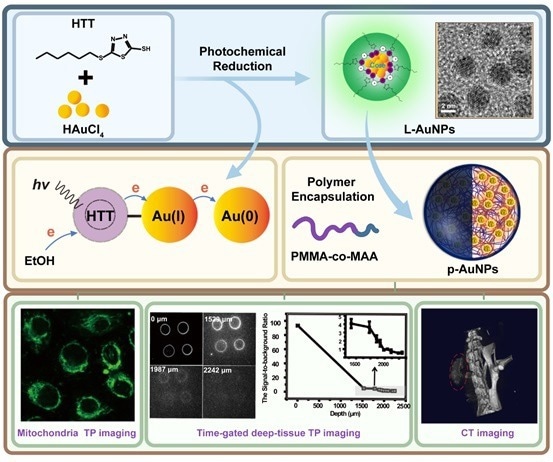Reviewed by Lexie CornerOct 22 2024
The Chinese researchers, under the direction of Professor Yuqiang Jiang of the Chinese Academy of Sciences’ Institute of Genetics and Developmental Biology, developed a simple photochemical process for creating highly luminescent gold nanoparticles (AuNPs) coated with 2-n-hexylthio-1,3,4-thiadiazole-5-thiol (L-AuNP@HTT). Their findings were published in Advanced Composites and Hybrid Materials.
 Novel Facile Photochemical Synthesis of Highly Efficient Luminescent Gold Nanoparticle and its Applications in Bioimaging. Image Credit: IGDB
Novel Facile Photochemical Synthesis of Highly Efficient Luminescent Gold Nanoparticle and its Applications in Bioimaging. Image Credit: IGDB
AuNPs are noble metal nanomaterials known for their exceptional biocompatibility, ease of functional modification, and unique physicochemical properties. These characteristics have led to their widespread use in cancer treatment, disease diagnosis, biosensing, and bioimaging.
Larger-than-2-nm luminescent gold nanoparticles (L-AuNPs) have shown exceptional performance, especially in biomedical imaging. However, their synthesis typically relies on labor-intensive and complex thermal reduction methods, which limit their broader application.
In a recent development, L-AuNPs with a diameter of 3.19 nm, referred to as L-AuNP@HTT, demonstrated exceptional photoluminescence (PL) characteristics. These include symmetric PL curve profiles, a narrow full width at half maximum (FWHM, ≤ 49 nm), a high quantum yield (φ, 12.9 %), and an ultra-long luminescence lifetime (~ 1 μs).
Additionally, their two-photon absorption (TPA) cross-sections (σ) were remarkably large, reaching up to 8.0 × 104 GM (1 GM = 10–50 cm4 s photo–1). The TPA cross section per particle can be further increased to 1.1 × 108 GM after additional polymer encapsulation treatment (i.e., p-AuNPs). This is significantly higher than that of conventional fluorescent dyes like Rhodamine and FITC, which are typically <102 GM.
It was also discovered that these prepared p-AuNPs had good photostability and effective mitochondrial targeting. Based on the p-AuNPs, scientists achieved high-quality in vivo computed tomography (CT), time-gated delayed imaging of deep tissues, and mitochondria-targeted two-photon excited luminescence (TPEL) imaging.
The team led by Professor Yuqiang Jiang collaborated with Peking University, Renmin University of China, the Institute of Acupuncture and Moxibustion, the Chinese Academy of Traditional Chinese Medicine, and the First Affiliated Hospital of Naval Medical University (Shanghai Changhai Hospital).
It opens up the possibility of efficiently synthesizing high-performing luminescent gold nanoparticles for a variety of bioimaging applications.
The study’s findings, titled “Highly luminescent gold nanoparticles prepared via a facile photochemical method for bioimaging applications,” were recently published in the journal Advanced Composites and Hybrid Materials.
National Natural Science Foundation of China, the Strategic Pilot of the Chinese Academy of Sciences, and the Sanya Yazhou Bay Science and Technology City Research Project supported the study.
Journal Reference:
Yang, L. et. al. (2024) Highly luminescent gold nanoparticles prepared via a facile photochemical method for bioimaging applications. Advanced Composites and Hybrid Materials. doi.org/10.1007/s42114-024-00964-w